|
|
 |
|
 |
| |
Publisher: Chairman Gong-Ru Lin Editors: Professor
Chao-Hsin Wu, Ms. Hsiao-wen Lin August 30, 2015 |
| |
|
 |
|
Congratulations to GIPO professor Sheng-Lung Huang’s team on their splendid invention of the “high speed submicron 3D tomography
for clinical use”. The project was presented to the media on April 21, 2015, and then technology transferred, with a high technology transfer fee, to an advanced medical instrument manufacturer to continue development and government certification.
For the full press release, please refer to the following website:
http://ntuvp.ntu.edu.tw/upload_files/pressconf/31news.pdf
For related news, please refer to the following NTU website:
http://ntuvp.ntu.edu.tw/vpforacademic_effort.aspx
Congratulations to GIPO professor Chih-I Wu and doctoral students Wei-Hsiang Lin, Yuan-Yen Lo, Tsung-Chin Cheng and Chen-Chih Hsu! Their work in cooperation with the California Institute of Technology (Caltech) was published in Nature Communications. The title of the article is “Single-step deposition of high-mobility graphene at reduced temperatures”.
Related website:
http://www.nature.com/ncomms/2015/150318/ncomms7620/full/ncomms7620.html
Congratulations to Professor Snow H. Tseng on being elected as an “Excellent NTU Mentor of the 103 Academic Year”.
|
|
 |
|
 |
|
| |
|
 |
|
March “GIPO Colloquium” Highlights
(Compiled by Li-Chi Yao) |
|
|
4:30 pm, Mar. 6 (Fri.), 2015 |
|
Speaker: |
Professor Yin-Chieh Lai (Department of Photonics, National Chiao Tung University) |
|
Topic: |
Mode-locked Fiber Laser Science and Technology |
| |
Professor Yin-Chieh Lai visited GIPO on Mar. 6 (Fri.) and delivered a speech concerning “Mode-locked Fiber Laser Science and Technology” at lecture theater 101, Barry Lam Hall. His speech was excellent and informative, and the professor interacted well with students. GIPO teachers and students were excited to attend, and learned a great deal. |
|
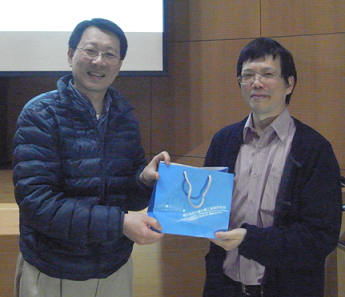 |
|
Professor Yin-Chieh Lai (right), and GIPO
chairman, Professor Gong-Ru Lin |
|
|
|
4:30 pm, Mar. 13 (Fri.), 2015 |
|
Speaker: |
Professor Si-Chen Lee (Department of Electrical Engineering, National Taiwan University) |
|
Topic: |
Information medicine – the discovery of X information |
| |
GIPO was honored to have invited Professor Si-Chen Lee, the former president of NTU, to deliver a speech concerning “Information medicine – the discovery of X information” on Mar. 13 (Fri.). His speech was fascinating and the professor interacted very well with students. GIPO teachers and students participated in this event with enthusiasm and learned a great deal. |
|
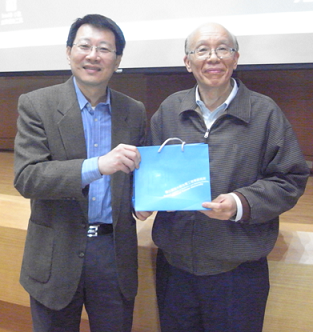 |
|
Professor Si-Chen Lee (right), and GIPO
chairman, Professor Gong-Ru Lin |
|
|
|
2:30 pm, Mar. 20 (Fri.), 2015 |
|
Speaker: |
Professor Victor Yang (Division of Neurosurgery, Dept. of Surgery, University of Toronto, Canada) |
|
Topic: |
Split spectrum Doppler OCT imaging - potential for endovascular neurosurgical imaging |
| |
Professor Victor Yang visited GIPO on Mar. 20 (Fri.) and delivered a speech concerning “Split spectrum Doppler OCT imaging - potential for endovascular neurosurgical imaging” at lecture theater 101, Barry Lam Hall. His speech was very informative, and the professor interacted well with his audience. GIPO teachers and students were excited to participate in this event and learned a great deal. |
|
|
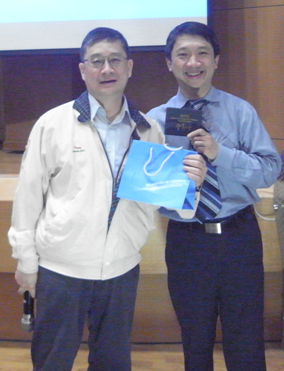 |
|
Professor Victor Yang (right), and the host of this speech, Professor C. C. (Chih-Chung)
Yang |
|
|
|
4:30 pm, Mar. 20 (Fri.), 2015 |
|
Speaker: |
Professor Ching-Fuh Lin (GIPO, NTU) |
|
Topic: |
Photonics for Environment and Health Protection |
| |
We were honored to have invited GIPO professor Ching-Fuh Lin to deliver a speech concerning “Photonics for Environment and Health Protection”. Professor Lin has written, under the pen name of Mulin, several books, newspaper columns, familiar essays, short stories and fairy tales. His speech was excellent and the professor interacted very well with students. GIPO teachers and students participated in this event with enthusiasm and learned a great deal. |
|
|
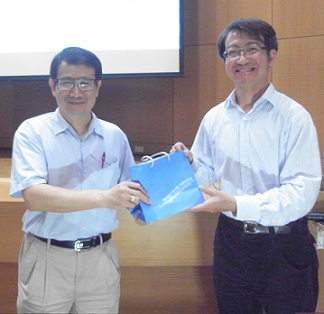 |
|
Professor Ching-Fuh Lin (left), and the host of this speech, Professor Chi-Kuang
Sun |
|
|
|
4:30 pm, Mar. 27 (Fri.), 2015 |
|
Speaker: |
Professor Der-Ray Haung (Department of Opto-Electronic Engineering, National Dong Hwa University) |
|
Topic: |
Potential Opportunities and Development Strategies of Solar Cells |
| |
We were honored to have invited Professor Der-Ray Haung to deliver a speech concerning “Potential Opportunities and Development Strategies of Solar Cells” on Mar. 27 (Fri.) at lecture theater 101, Barry Lam Hall. His speech was interesting and informative. GIPO teachers and students were excited to attend, and learned a great deal. |
|
|
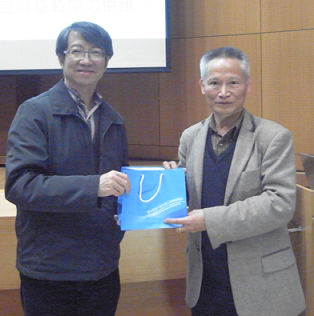 |
|
Professor Der-Ray Haung (right), and the host of this speech, Professor Chi-Kuang
Sun |
|
|
April “GIPO Colloquium” Highlights
(Compiled by Li-Chi Yao) |
|
|
4:30 pm, April 24 (Fri.), 2015 |
|
Speaker: |
Professor Arthur Chiou (Institute of Biophotonics Engineering, National Yang-Ming University) |
|
Topic: |
Optical Biomicrorheology: A Powerful Tool for Cell Mechanics |
| |
Professor Arthur Chiou visited GIPO on April 24 (Fri.) and delivered a speech concerning “Optical Biomicrorheology: A Powerful Tool for Cell Mechanics” at lecture theater 101, Barry Lam Hall. His speech was interesting and the professor interacted well with students. GIPO teachers and students were excited to participate in this event, and benefitted a great deal. |
|
|
 |
|
Professor Arthur Chiou (right), and the host of this speech, Professor Chi-Kuang
Sun |
|
|
May “GIPO Colloquium” Highlights
(Compiled by Li-Chi Yao) |
|
|
4:30 pm, May 1 (Fri.), 2015 |
|
Speaker: |
Professor Chung-Hao Tien (Department of Photonics, National Chiao Tung University) |
|
Topic: |
Digital Optics and Iris Recognition |
| |
Professor Chung-Hao Tien visited GIPO on May 1 (Fri.) and delivered a speech concerning “Digital Optics and Iris Recognition” at lecture theater 101, Barry Lam Hall. His speech was very educational and the professor interacted well with students. GIPO teachers and students were excited to participate in this event and learned a great deal. |
|
 |
|
Professor Chung-Hao Tien (right), and the host of this speech, Professor Chi-Kuang
Sun |
|
|
|
4:30 pm, May 8 (Fri.), 2015 |
|
Speaker: |
Professor Dar-Bin Shieh (Institute of Oral Medicine, National Cheng Kung University) |
|
Topic: |
The application of micro nano science and technology in biomedicine |
| |
Professor Dar-Bin Shieh visited GIPO on May 8 (Fri.) and delivered a speech concerning “The application of micro nano science and technology in biomedicine” at lecture theater 101, Barry Lam Hall. His speech was very interesting and the professor interacted well with students. GIPO teachers and students were excited to participate in this event and learned a great deal. |
|
 |
|
Professor Dar-Bin Shieh (left), and the host of this speech, Professor Lung-Han Peng |
|
|
|
4:30 pm, May 15 (Fri.), 2015 |
|
Speaker: |
Vice general manager Ta-Chun Luo (Keysight Technologies Inc.) |
|
Topic: |
Concentration, enthusiasm and speed, 3 key abilities of working in transnational high-tech companies |
| |
Vice general manager Ta-Chun Luo visited GIPO on May 15 (Fri.) and delivered a speech concerning “Concentration, enthusiasm and speed, 3 key abilities of working in transnational high-tech companies” at lecture theater 101, Barry Lam Hall. His speech was fascinating and the professor interacted well with students. GIPO teachers and students were excited to participate in this event and gained a lot from the experience. |
|
 |
|
Vice general manager
Ta-Chun Luo (right), and the host of this speech, Professor Chi-Kuang
Sun |
|
|
|
4:30 pm, May 29 (Fri.), 2015 |
|
Speaker: |
Dr. Huan-Cheng Chang (Institute of Atomic and Molecular Sciences, Academia Sinica) |
|
Topic: |
Fluorescence Imaging and Quantum Sensing Using Nitrogen-Vacancy Centers in Nanodiamonds |
| |
Dr. Huan-Cheng Chang visited GIPO on May 29 (Fri.) and delivered a speech concerning “Fluorescence Imaging and Quantum Sensing Using Nitrogen-Vacancy Centers in Nanodiamonds” at lecture theater 105, EE-II Building. His speech was very informative and the professor interacted well with students. GIPO teachers and students were happy to participate in this event and learned a great deal. |
|
 |
|
Dr. Huan-Cheng Chang (left), and GIPO
chairman, Professor Gong-Ru Lin |
|
|
~ GIPO Laboratories’ Small Emergency Response Drill
~
(Time: 2:17 ~
3:00 pm, May 4, 2015; Location: Room
405, EE-II Building)
Composed by
Tzu-Yu Chen
The purpose of this drill is, in cases of laboratory emergencies, to ensure that rescuers perform their jobs properly, that correct and effective ways to control disasters are taken, and that laboratory personnel have the knowledge to cope with emergencies and evacuate safely. This drill took place under the assumption that a laboratory had caught fire and a toxic substance had leaked from the scene. This part of the drill was completed in coordination with the “Toxicant Disaster Drill” of the Department of Environmental Protection, Taipei City Government.
At 2:17 pm, room 405 of EE-II Building caught fire, and was brought under control.
However, the formaldehyde which students were using in an experiment leaked unexpectedly. After having taken the necessary steps for protection, the leakage was soon reported to the GIPO office and an overall evacuation of nearby personnel was immediately called for. GIPO office at once requested EE-II Building to broadcast an emergency evacuation, and asked Professor Jui-Che Tsai, GIPO Environmental Protection & Occupational Safety & Health Center commissioner, Professor Ching-Fuh Lin, the person in charge of the laboratory 405, Professor Gong-Ru Lin, GIPO chairman, and Professor Jian-Jang Huang, GIPO vice chairman, to assemble at the west side square of EE-II Building and establish a command post next to room 455. The GIPO office also reported the incident to related offices and asked them for assistance according to NTU regulations.
The post commander, i.e. GIPO Environmental Protection & Occupational Safety & Health Center commissioner, assembled and organized personnel into rescue teams, assigned missions to each team, and controlled the situation on the spot to each task was covered. Each team reported to the post as soon as their mission was completed. Rescue personnel had been organized into a promulgation team, evacuation team, safety team, fire fighting team, and first aid and care team. The missions were directing evacuated persons to stay away from the hall, setting up no-entry signs, extinguishing the fire, and setting up a first aid/care post. The GIPO chairman, vice chairman and the post commander controlled the situation on the scene, directed and sent rescue crews accordingly, and double checked that all persons in the laboratories had all been evacuated. After EPOSH center of NTU had sent B protective clothing and other supplies to the post, the commander ordered a laboratory person to put on the protective clothing and go into the laboratory to seal the waste. After the person reported back that he had done his job, the promulgation team reported to GIPO office that all missions had been duly completed. GIPO office reported the situation to other related offices, and the drill was completed successfully.
This drill had enforced our capabilities of coping with emergencies. We hereby thanked the generous cooperation of all participating teachers, staff members, and students.
The observing officer of the Department of Environmental Protection, Taipei City Government made the following suggestions:
1. Laboratories should all be equipped with protective clothing so as to enable them to take immediate action against toxicant leakages.
2. The command post should be set up outside of the building.
3. An all-campus evacuation alert should be announced as soon as possible.
4.
In organizing teams, rescue crews should be assembled at the command post first and then assigned their missions.
5.
The process of putting on protective clothing should be practiced more often.
6. Off-limits areas should be set up and reinforced, and people should be prohibited from passing through.
|
 |
 |
|
An accident occurred at room 405, EE-II Building; a toxicant, formaldehyde, was leaked accidently when students were doing an experiment. |
The experimenting students reporting the accident. |
|
 |
 |
|
After having received the message, GIPO office at once notified other relevant offices. |
Students of room 405 notified other nearby laboratories of the accident and asked them to withdraw. |
|
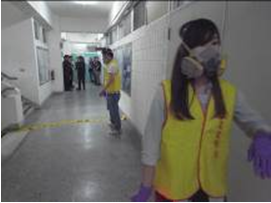 |
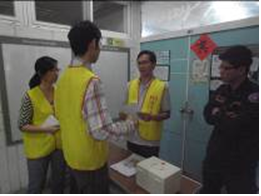 |
|
Students of room 405 set up off-limits areas and asked nearby people to withdraw. |
After the command post was set up, students of room 405 reported the accident to the commander, who in turn organized teams for different missions. |
|
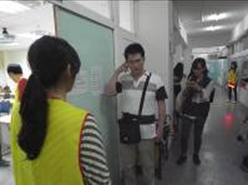 |
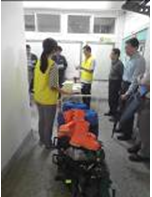 |
|
GIPO office reported the accident to the Department of Environmental Protection, Taipei City Government, and asked them for help. |
After EPOSH center of NTU had sent B protective clothing and other supplies to the post, the commander ordered a laboratory member to put on the protective clothing and go into the laboratory to seal the waste. |
|
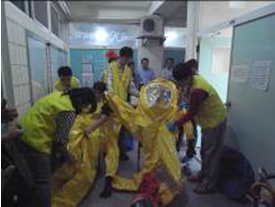 |
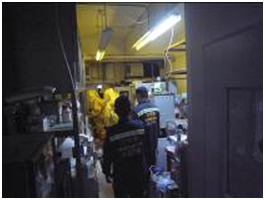 |
|
A student of room 405 putting on B protective clothing. |
A student of room 405 in B protective clothing entering the laboratory in question to seal the waste. |
|
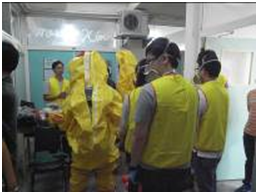 |
 |
|
The student of room 405 has returned and reported to the commander after having done his job. |
The observing officer of the Department of Environmental Protection, Taipei City Government giving advice at the end of the drill. |
|
|
 |
|
 |
|
| |
|
 |
|
~ The Spring
Academy Industry Forum between GIPO and
Coretronic Corporation ~
(Time:
April 20, 2015;
Location:
Room 201, Barry Lam Hall, NTU)
Composed by
Tzu-Yu Chen
GIPO held a Spring Academy Industry Forum with
Coretronic Corporation on April 20 (Fri.), 2015.
Coretronic’s vice general manager Fu-Ming
Chuang, assistant general manager Chi-Tang
Hsieh, senior director Wei-Ming Lin, director
Chun-Chung Hsiao, and director Dong-Hong Lu, came
to speak with us about opportunities for
cooperation. First, Coretronic explained the
general direction of possible cooperative
projects to us. Afterwards, GIPO’s vice chairman
Jian-Jang Huang, professor Ching-Fuh Lin,
professor Lung-Han Peng, professor Yih-Peng
Chiou, associate professor Guo-Dung Su,
associate professor Yuh-Renn Wu, doctoral
student Shih-Yu Tu, on behalf of professor Hoang-Yan
Lin, and graduate student I-Te Lee, on behalf of
assistant professor Chao-Hsin Wu, briefed
Coretronic respectively on their main fields of
study. Finally, both sides discussed the
potential of cooperative research thoroughly.
The forum increased the likelihood of joint
research between GIPO and Coretronic.
|
|
 |
|
 |
|
| |
|
 |
The application of Plasmonic infrared thermal emitters in cancer therapy
Professor Si-Chen Lee
Graduate Institute of Photonics and
Optoelectronics, National Taiwan
University
Infrared technologies have wide applications in silicon photonics, biotechnology, cancer therapy, night vision, communication and environmental protection. We developed narrow bandwidth plasmonic and waveguide thermal emitters achieved by Au/SiO2/Au tri-layer structures. Manipulate the blackbody radiation spectra of the heated device to obtain a narrow bandwidth infrared light source by controlling the period or metal width of top metallic layer to select emission wavelength. Fig. 1(a) shows a typical metal-dielectric-metal structure. There are two major kinds of infrared thermal emitters, including plasmonic thermal emitter (PTE) and waveguide thermal emitter (WTE). The thermal emission spectra of PTE and WTE are shown in Fig.1(c)-(d), respectively. Furthermore, we demonstrate dual-wavelength LSP thermal emitters by using double tri-layer Au/SiO2/Au structures with different SiO2 thickness, as shown in Fig.1 (e). Fig. 1(f) shows the waveguide type dual-wavelength thermal emitters. We use a metallic grating embedded in the central dielectric layer of a waveguide thermal emitter as a beam splitter, dividing the device into two waveguide structures for TE and TM polarizations. We can use a polarizer to select the wavelength we need. Fig.2 shows the effect of MIR exposure on the actin filaments and focal adhesions of MDA-MB-231 breast cancer cells. We found that mid-infrared (3~5 μm region) exposure inhibited breast cancer cell proliferation, induced morphological changes by altering the cellular distribution of cytoskeletal components, as shown in Fig. 2(a)-(b). It has potential to be used in the breast cancer therapy in the future.
|
 |
|
Fig. 1 (a) The scheme of MIM structure. (b) Dispersion diagram of PTE with SP and LSP modes. (c)(d) is the emission spectra of PTE and WTE. The emission spectra of (e) dual-wavelength LSP thermal emitters by using double tri-layer Au/SiO2/Au structures with different SiO2 thickness and (f) the waveguide type dual-wavelength thermal emitters with different polarizations. |
|
 |
|
Fig. 2. (a) Three breast cancer cells. (b) Effect of MIR exposure on the actin filaments and focal adhesions of MDA-MB-231 cells. |
Extending resonant wavelengths of contour bowtie nano-antennas with fixed footprint size
Professor Hung-chun Chang
Graduate Institute of Photonics and
Optoelectronics, National Taiwan
University
Properly designed plasmonic bowtie antennas (BAs) are known to produce “hot spots” in the antenna gap and have been extensively investigated in the visible and infrared wavelength range both theoretically and experimentally. The dependence of the field enhancement and confinement in the gap and the resonant wavelength,
λres, on various parameters of the BA geometry has been widely studied. It has been known that
λres is proportional to the antenna length. Several designs have been proposed to redshift the resonance of the nano-antenna over a wide wavelength range while maintaining the antenna size the same. A simple one proposed by Sederberg
et al. [Opt. Express
19, 15532 (2011)] is contour bowtie antennas (CBAs) involving air holes with the antenna response tuned by varying the contour thickness. Fig. 1(a) depicts the three-dimensional (3D) structure of an isolated gold BA under a plane-wave illumination from the air side and Fig. 1(b) shows the gold contour of the CBA. In recent research, we have proposed a modified CBA (MCBA) structure, as shown in Fig. 1(c) to further red-shift the spectral response under the same CBA footprint size.
With our in-house developed 3D finite-difference
time-domain (FDTD) method, we first simulated and compared the spectra of the
conventional solid BA, the CBA, and our proposed MCBA. Referring to Figs.
1(a)–1(c), the gap area is 30 nm x 30 nm, the gold film thickness is
d
= 36 nm, the contour width is
t
= 30 nm, the relative permittivity of the silica substrate is 2.25, and the
dielectric function of gold is described by the Drude model with ε∞ =
1, ωp
= 11500 (THz), and γp
= 92 (THz). Figure
1(d)
shows the gap enhancement factor versus the wavelength for the solid BA (θ
= 90°), the CBA (θ
= 90°), and the MCBA with different flare angles
θ
from 110° to 170° with 20° increment. The original resonance of the solid BA
occurs at
λres
= 1.34 μm, and its corresponding electric field enhancement in the gap is 22.5.
For the CBA,
λres
redshifts to 2.22 μm and the field enhancement increases to 37.7. For the MCBA,
a further redshift trend occurs with increasing
θ.
The resonance reaches to 2.66 μm as
θ
= 170°, and its corresponding field enhancement is 31.4, which is still better
than that of BA. We are working on extending the resonant paths by utilizing the
hollow spaces of the MCBA to further broaden the resonant spectral range under
the same antenna footprint size. (Hui-Hsin Hsiao, Shian-Min Chiou, Yu-Ping
Chang, and Hung-chun Chang, to appear in
META’15 Abstracts.)
|
 |
|
Figure 1 (a) The 3D structure of an isolated BA under a plane-wave illumination from the air side. (b) The schematic view of the BA. (b) That of the CBA. (c) That of the MCBA. (d) Gap enhancement spectra for the BA, the CBA (θ = 90°), and the MCBA (θ = 110°, 130°, 150°, 170°). |
Cancer Cell Uptake Behavior of Au Nanoring and Its Localized Surface Plasmon Resonance Induced Cell Inactivation
Professor C. C. (Chih-Chung) Yang
Graduate Institute of Photonics and
Optoelectronics, National Taiwan
University
Au nanorings (NRIs), which have the localized surface plasmon resonance (LSPR) wavelength around 1058 nm, either with or without linked antibodies, are applied to SAS oral cancer cells for cell inactivation through the LSPR-induced photothermal effect when they are illuminated by a laser of 1065 nm in wavelength. Different incubation times of cells with Au NRIs are considered for observing the variations of cell uptake efficiency of Au NRI and the threshold laser intensity for cell inactivation. In each case of incubation time, cell sample is washed for evaluating the total Au NRI number per cell adsorbed and internalized by the cells based on inductively coupled plasma mass spectrometry measurement. Also, the Au NRIs remaining on cell membrane are etched with KI/I2 solution to evaluate the internalized Au NRI number per cell. The threshold laser intensities for cell inactivation before washout, after washout, and after KI/I2 etching are calibrated from the circular area sizes of inactivated cells around the illuminated laser spot center with various laser power levels. By using Au NRIs with antibodies (NRI-AB), the internalized Au NRI number per cell increases monotonically with incubation time up to 24 hrs. However, the number of Au NRI remaining on cell membrane reaches a maximum at 12 hrs in incubation time. The cell uptake behavior of an Au NRI without antibodies (NRI-control) is similar to that with antibodies except that the uptake NRI number is significantly smaller and the incubation time for the maximum NRI number remaining on cell membrane is delayed to 20 hrs. By comparing the threshold laser intensities before and after KI/I2 etching, it is found that the Au NRIs remaining on cell membrane cause more effective cancer cell inactivation, when compared with the internalized Au NRIs.
|
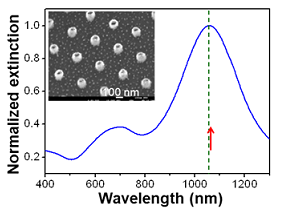 |
|
Fig.
1 Normalized extinction spectrum of the
fabricated Au NRIs in PBS. The inset shows
the SEM image of the Au NRIs before liftoff. |
|
 |
|
Fig. 2 (a)-(d): Microscopic images of cells after laser illumination with the laser powers of 230, 200, 200, and 180 mW, respectively, under the pre-washout condition when NRI-AB is applied to the cells and the
incubation time is 16 hrs. (e)-(h) and (i)-(l): Corresponding microscopic images under the post-washout and after-etching conditions, respectively. |
|
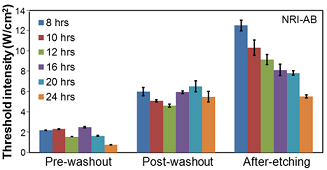 |
|
Fig. 3 Threshold laser intensities under the pre-washout, post-washout, and after-etching conditions for various incubation times when NRI-AB is applied to the cells. |
|
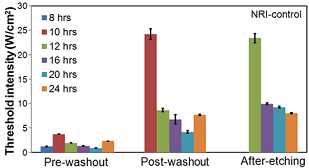 |
|
Fig. 4 Threshold laser intensities similar to those in Fig.3 when NRI-control is applied to the cells. |
Enhancements of the emission and light extraction of a radiating dipole coupled with localized surface plasmon induced on a surface metal nanoparticle in a light-emitting device
Professor Y. W. Kiang’s Laboratory
Graduate Institute of Photonics and
Optoelectronics, National Taiwan
University
The radiated power enhancement and more congregated radiation of a radiating dipole within a GaN material when it is coupled with the localized surface plasmon (LSP) resonance modes induced on a surface Ag nanoparticle (NP) are numerically demonstrated. The numerical study is based on an algorithm including the induction of LSP resonance on the Ag NP by the source dipole and the feedback effect of the LSP resonance field on the source dipole behavior. The spectral peaks of radiated power enhancement correspond to the substrate LSP resonance modes with mode fields mainly distributed around the bottom of the Ag NP such that the coupling system radiates mainly into the GaN half-space. By moving the radiating dipole laterally away from the bottom of the Ag NP, the spectral peaks of radiated power enhancement red shift and their levels diminish with increasing lateral distance. The radiation patterns in the GaN half-space show more congregated radiation around the vertical direction, indicating that the light extraction efficiency can be enhanced in an LSP-coupled light-emitting device with surface metal NPs.
|
 |
|
Fig. 1 Demonstration of the problem geometry, in which an Ag NP is placed on the surface of a thick GaN layer with an embedded thin QW layer at the depth of
d. A radiating dipole, which is represented by a thick (red) arrow, is located in the QW layer. |
|
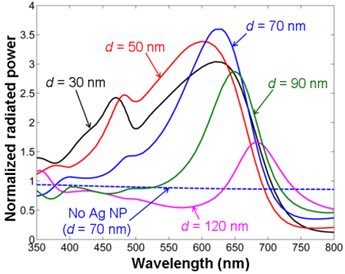 |
|
Fig. 2 Normalized downward radiated powers of the NP-dipole coupling system as functions of wavelength for
d = 30, 50, 70, 90, and 120 nm when the dipole is located exactly below the Ag NP, i.e., at x = 0. The Ag NP is surrounded by air in the upper-half-space. For comparison, the result in the case of no Ag NP at the air/GaN interface with
d = 70 nm is also plotted as the dashed curve. |
Ordering InGaP epilayer directly grown on Ge substrate
Professor Hao-Hsiung Lin
Graduate Institute of Photonics and
Optoelectronics, National Taiwan
University
Ternary InGaP lattice-matched to GaAs has been well
studied for decades and found applications to several important photonic and
electronic devices, such as heterojunction bipolar transistors, laser diodes,
and so on. Recently, the ternary has been deposited on Ge substrates as one of
the subcell of the InGaP/InGaAs/Ge triple-junction tandem solar cells for high
concentration photovoltaic. In this application, although the lattice constant
of InGaP has been constrained to that of Ge substrate, one still can adjust the
energy gap of InGaP by controlling the ordering of the ternary. The growth of
the ternary semiconductor under certain conditions has a tendency towards atomic
ordering due to the differences of the atomic size and the binding energy, which
can spontaneously adopt a CuPt-type ordered structure. Fig. 1(a), indicates a
good InGaP/Ge interface. Note that the miscut of the Ge substrate is towards
 direction. Steps resulting from the miscut are expected to be observed in the
lattice image of the
direction. Steps resulting from the miscut are expected to be observed in the
lattice image of the
 plane.
However, as shown in Fig. 1(b), we did not observe the expected steps. The TED
patterns with plane.
However, as shown in Fig. 1(b), we did not observe the expected steps. The TED
patterns with
 and and
 zone
axes are shown in Fig. 2(a) and (b), respectively. As can be seen, only
superstructure spots zone
axes are shown in Fig. 2(a) and (b), respectively. As can be seen, only
superstructure spots
 … along … along
 direction are observed. For
direction are observed. For
 growth
plane, there are four growth
plane, there are four
 planes
possible for Cu-Pt ordering. In Fig. 3(a), a sharp peak at 354 cm-1
is observed. The peak has been previous reported in the literature, and was
attributed to the trigonal cationic arrangement with LO symmetry. In order to
understand the behavior of this mode, the normalized Raman spectra are plotted
in Fig. 3(b). According to the C3v selection rule, the 354 cm-1
mode is only forbidden in planes
possible for Cu-Pt ordering. In Fig. 3(a), a sharp peak at 354 cm-1
is observed. The peak has been previous reported in the literature, and was
attributed to the trigonal cationic arrangement with LO symmetry. In order to
understand the behavior of this mode, the normalized Raman spectra are plotted
in Fig. 3(b). According to the C3v selection rule, the 354 cm-1
mode is only forbidden in configuration.
configuration.
|
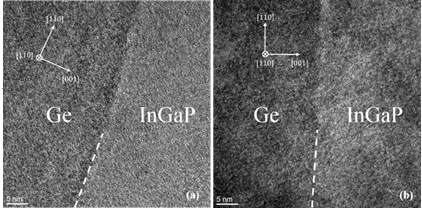 |
|
Fig. 1 High resolution cross-sectional TEM images of the InGaP/Ge interfaces. (a) on  plane and (b) on plane and (b) on  plane. plane. |
|
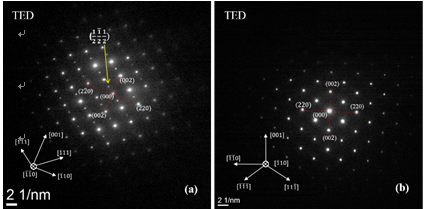 |
|
Fig. 2 TED patterns of InGaP epilayer. (a) Zone axis is  and (b) zone axis is and (b) zone axis is  . . |
|
|
|
 |
|
 |
|
| |
|
|
 |
|
 |
|
|
|